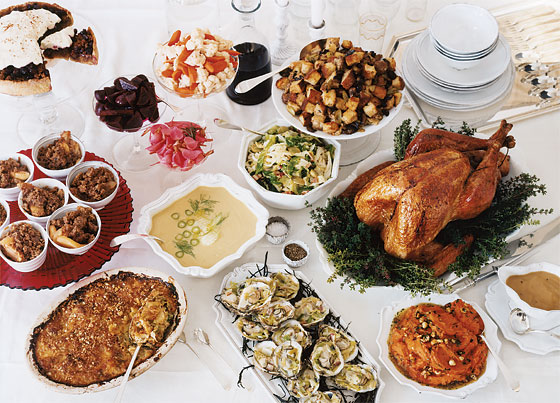
The Pilgrims, of course, were locavores, and now, after decades of factory farming and MSG, we’ve come full circle. Eating minimally processed food from nearby sources has become a New York, and national, obsession. In that spirit, we’ve assembled “A Local Thanksgiving”—a complete holiday feast, created by the most ingredients-driven New York chefs and sourced from area farmers. Yes, you may pay a bit more, but what you lose in parsimony you gain in ecological correctness and, most important, deliciousness. Besides, here’s something else the Pilgrims understood: Even in a world of tight resources, there are occasions when a small splurge is exactly what one needs.
All recipes serve eight.
Dairyless Local-Fennel Soup From Blue Hill and Blue Hill at Stone Barns chef Dan Barber. Roasted Oysters With Leeks & Bacon From Eighty One chef Ed Brown. Relish Plate of Homemade Pickles From Five Points, Cookshop, and Hundred Acres chef Marc Meyer. Duck-Fat-Rubbed Roast Turkey From Telepan chef Bill Telepan. Herb Sausage and Mushroom Stuffing From Telepan chef Bill Telepan. Braised Savoy Cabbage From BLT Market chef Laurent Tourondel. Maple-Whipped Sweet Potatoes From Forge chef Marc Forgione. Potato-and-Brussels-Sprout Gratin From Butter chef Alex Guarnaschelli. Deep-Dish Pumpkin Pie From Back Forty and Savoy chef Peter Hoffman. Apple CrispFrom Convivio and Alto chef Michael White’s mother.
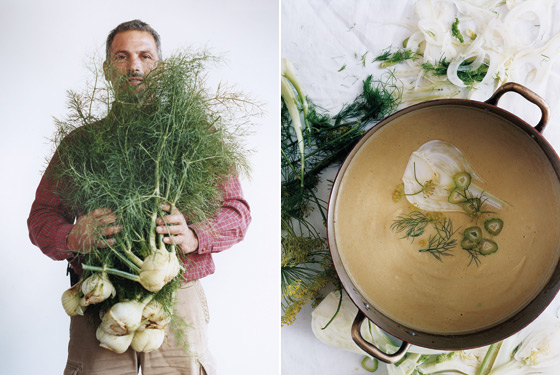
Dairyless Local-Fennel Soup
THE CHEF:
Dan Barber (Blue Hill and Blue Hill at Stone Barns)
Instead of the traditional pumpkin or squash soup, Dan Barber prefers the anise-flavored fennel. “It’s so silky and rich, you don’t need to add dairy,” he says. “Which means it’s hearty without being filling, so you can enjoy the rest of the meal.” Barber has experimented with many varieties for flavor, but Ken Migliorelli’s oversize bulbs, he’s says, “are the sweetest.”
THE FARMER:
Ken Migliorelli (Migliorelli Farm)Tivoli; 845-757-3276 or migliorelli.com
Ken Migliorelli comes from a family of Italian farmers—when his grandfather emigrated from Italy in the thirties, he brought broccoli-rabe seeds with him and planted them on his farm in the Bronx. That same strain of seed is now grown on Migliorelli’s farm in Dutchess County, which is one of the largest regional farms specializing in Italian products—broccoli rabe, arugula, and dandelion, among 140 other items. “The fennel’s grown in a sandy loam soil,” says Migliorelli. “That’s what makes it sweet.”
THE RECIPE:
VEGETABLE STOCK
1 tablespoon grapeseed oil
1 1/4 cups medium-diced onion
1/4 cup thinly sliced shallots
1/4 cup medium-diced leeks
1/2 cup medium-diced carrots
3 1/4 cups medium-diced fennel
Salt
1/8 teaspoon coriander seeds
1/8 teaspoon black peppercorns
6 sprigs parsley
3 sprigs thyme
1/2 head garlic
Heat the oil in a large saucepan, add the vegetables and a pinch of salt, and sweat over low heat. Add the coriander seeds, peppercorns, parsley, thyme, garlic, and 6 cups water. Bring to a boil, reduce heat, and simmer for 50 minutes. Strain and chill.
FENNEL SOUP
3 tablespoons olive oil
1 onion, chopped
3 small shallots, minced
3 1/2 cups diced fennel, white part only, reserving green fronds for garnish
1 apple, peeled and diced
Salt and ground black pepper
1 tablespoon fennel seeds, crushed
4 cups vegetable stock (recipe above)
1/2 teaspoon chopped thyme
Heat 1 tablespoon oil in a large saucepan, add the onion and shallots, and sweat until translucent. Add the fennel and apple, and season with salt and pepper. Cook for a few minutes before adding the fennel seeds and stock, bring to a boil, and simmer for 30 minutes. Add thyme and season to taste with salt and pepper.
Transfer to a blender and purée, adding the remaining 2 tablespoons olive oil. Return to saucepan and heat gently. Garnish with fennel fronds.
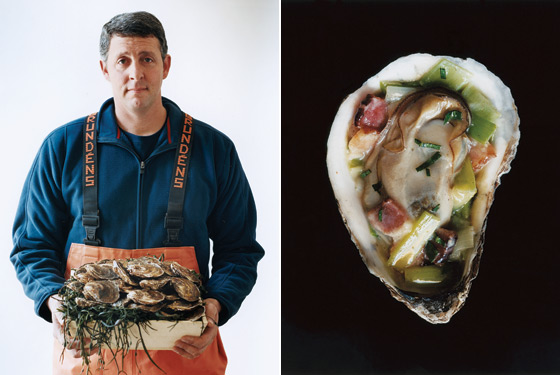
Roasted Oysters With Leeks & Bacon
THE CHEF:
Ed Brown (Eighty One)
“Shucking oysters on Thanksgiving is a nightmare” says Ed Brown. Instead, he recommends roasting the oysters so the shells open on their own. Roasting concentrates the brine, he adds. The Blue Points from Blue Island Oyster farm “sparkle with salinity and have a great ocean flavor,” Brown says.
THE FARMER:
Chris Quartuccio (Blue Island Oyster Farm) Blue Point; 631-987-0106 or blueislandoyster.com
Long Island native Chris Quartuccio started clamming in the Great South Bay as a childhood hobby, but by 1985, the area was overharvested. Next he turned to oyster diving on the North Shore, but in the late nineties the oysters were wiped out by a disease. “After that, I had the opportunity to buy a house and dock right by the Fire Island Inlet, which is ideal for growing oysters,” he says. Quartuccio now runs the No. 1 oyster and clam distributor in the New York area, and his farm produces the only genuine Blue Point Oysters cultivated in the bay.
THE RECIPE:
1 teaspoon softened butter
4 ounces sliced bacon, chopped
2 cloves garlic, crushed
8 cups fresh leeks, white part only, diced about 1/2-inch square
3/4 cup white wine
3/4 cup light fish stock (chicken stock can be substituted)
2/3 cup heavy cream
1 tablespoon chopped tarragon
1/4 teaspoon grated nutmeg
1/4 teaspoon cayenne pepper
Salt and ground black pepper
2 pounds kosher salt for roasting
32 medium-size oysters, scrubbed well twice, then soaked in ice water for 1 hour
Preheat the oven to 400 degrees. Add the butter, bacon, and garlic to a large saucepan set over medium heat, and sauté for 2 minutes. Add the leeks, and sweat without coloring, until soft, about 8 minutes. Add the wine, and reduce until the pan is dry. Add the stock, and reduce until dry. Add the cream; reduce until all the ingredients come together as one. Add the tarragon, nutmeg, and cayenne, and season with salt and pepper. Discard the garlic, and keep mixture warm.
Spread a layer of salt over a baking sheet. Set all the oysters into salt, rounded side down so tops are level. Roast in the oven until the top shell loosens and the oyster starts to open, about 15 minutes. Using a butter knife, carefully remove the top shell, scraping the shell as you go to detach the oyster, making sure not to lose any liquid in the oyster shell. Divide the leek mixture, about 1 tablespoon per oyster, evenly over the roasted oysters and return to oven for 5 minutes. Serve immediately.
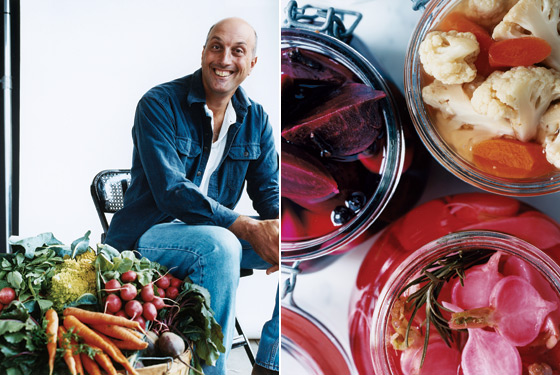
Relish Plate of Homemade Pickles
THE CHEF:
Marc Meyer (Five Points, Cookshop, and Hundred Acres)
“Pickled vegetables awaken the palate with their rich, concentrated flavor,” says Marc Meyer, whose family hails from Eastern Europe, where pickles are an essential part of any meal. The trinity for pickling is sugar, salt, and vinegar, “and it’s easy to pickle vegetables at home with just these three ingredients,” he says. In the fall, Meyer likes to pickle carrots, cauliflower, beets, and radishes.
THE FARMER:
Marc Phillips (Phillips Farms) Milford, N.J.; 908-995-0022 or phillipsfarms.com
When Marc Phillips took over his family’s fourth-generation, 175-acre hay farm in 1987, he felt it was time for a change. As an effort to improve the business, Phillips began growing berries, lettuce, and asparagus. Luckily, he found that the heavy, stony high ground set above the Delaware River provided excellent conditions for fruit, while the light, sandy soil in the river bottom was well suited to vegetables. Now Phillips grows roughly 60 types of vegetables, including beets, carrots, cauliflower, and radishes; all are at their prime in late autumn.
THE RECIPE:
ROASTED-BEET PICKLES
10 to 12 small to medium beets
1 3/4 cups sugar
2 cups distilled white vinegar
6 cloves garlic, peeled
2 whole cinnamon sticks
1 teaspoon whole cloves
1/2 teaspoon allspice berries
3 whole dried red chiles
Preheat oven to 350 degrees. Place the beets in a shallow roasting pan; add water until the beets are half submerged. Cover with aluminum foil and roast until the beets are tender when pierced with a small knife. Peel the beets under cold running water, quarter them.
Combine the sugar, 2 cups water, vinegar, garlic, and spices in a saucepan and bring to a boil. Simmer for 10 minutes. Pour over the beets. Allow to cool to room temperature and then refrigerate.
RADISH PICKLES
10 to 12 medium radishes, halved
2 tablespoons sea salt
1/4 cup sugar
1 cup distilled white vinegar
1 rosemary branch
Toss radishes with salt in a bowl. Allow to stand for 20 minutes.
Add sugar, vinegar, and rosemary to a saucepan and bring to a boil and simmer for 5 minutes. Drain the radishes, rinse, and put in a preserving jar. Cover with vinegar and allow to cool. Refrigerate.
CAULIFLOWER AND CARROT PICKLES
2 cups sherry vinegar
1 cup sugar
1/4 cup kosher salt
1/2 cauliflower, cut into florets
2 medium carrots, cut on the bias
In a saucepan combine vinegar, sugar, and salt, and boil for 3 to 4 minutes. Add the vegetables and simmer for 6 to 7 minutes. Cool and refrigerate.

Duck-Fat-Rubbed Roast Turkey
THE CHEF:
Bill Telepan (Telepan)
Brining is all well and good, but it’s messy and takes up a lot of room in the fridge. Bill Telepan prefers rubbing the turkey with duck fat and salt before cooking. “It makes the meat tender and gives it a nice, crispy skin,” he says. Snowdance Farm’s broad-breasted white turkeys “have superior flavor and a nice firm texture,” he says. He gives the bird a quick burst in the oven at 475 degrees for 30 minutes, which browns the skin and seals in the juices, and then reduces the temperature to cook the bird for another hour.
THE FARMER:
Marc Jaffe (Snowdance Farm) Livingston Manor; 845-439-5561
Marc Jaffe, a lifelong New Yorker, lived in Manhattan until 9/11. “My second child was born soon after, and living in an apartment two blocks below Canal Street was too stressful,” he says. So Jaffe and his wife, Susan, decided to move to their house in the Catskills. “I started with a small investment of 150 chickens,” he says. Today, Jaffe raises over 7,000 chickens a year and 250 broad-breasted white turkeys. They’re raised outdoors and are grass-fed, making them flavorful and tender.
THE RECIPE:
1/4 cup salt
1 tablespoon white wine
1/4 cup melted duck fat (available at D’Artagnan and gourmet stores)
2 shallots, chopped
2 garlic cloves, minced
2 tablespoons chopped thyme
1 turkey, 12 to 14 pounds
11/2 sticks softened butter
Salt and ground black pepper
Combine the salt, wine, duck fat, shallots, garlic, and thyme in a bowl. Rub two-thirds of the mixture all over the exterior of the turkey using your hands; rub the remaining third in the cavity of the bird. Set the turkey in a large bowl and cover with plastic wrap or tin foil and refrigerate overnight or up to 2 days.
Preheat the oven to 475 degrees.
Rinse the turkey, brush off the shallots and garlic, and pat dry with a paper towel. Place the bird on a roasting rack. Spread butter over the turkey, season with a little salt and pepper, and place in the oven. Cook the turkey for 30 minutes, reduce the temperature to 375 degrees, and baste the bird every 15 to 20 minutes until the internal temperature of the leg reaches 155 degrees when tested with an instant-read thermometer (about 1½ hours for a 14-pound turkey).
Remove the bird from the oven; let it rest 15 minutes before carving.
GIBLET STOCK
Turkey giblets and wing tips
1 onion, finely chopped
1 carrot, finely chopped
1 celery stalk, finely chopped
1 head garlic, split
1 teaspoon black peppercorns
2 sprigs thyme
2 sprigs parsley
5 cups chicken stock
Place the turkey giblets, wing tips, and all other ingredients in a saucepan, bring to a boil, and simmer for 2 hours.
TURKEY GRAVY
2 ounces butter
1/4 cup flour
4 cups giblet stock
Remove the turkey from the roasting pan. Pour off drippings, if any, and skim fat.
Set roasting pan over medium heat and melt butter or turkey fat in the pan. Whisk in flour, blend together, and cook for about 1 minute, stirring constantly. Stir in stock and scrape the bottom of the pan well. Bring to a boil, transfer to a saucepan, and simmer slowly for about 10 minutes. Add any juice from the resting bird to the pan and bring to a boil. If the gravy gets too thick, add a little stock or water. Season to taste with salt and pepper; strain.
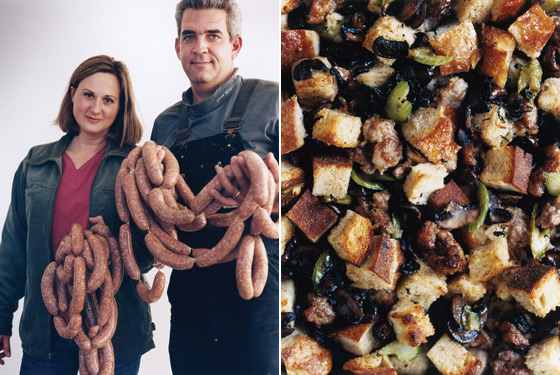
Herb Sausage and Mushroom Stuffing
THE CHEF:
Bill Telepan
Keep the stuffing out of the bird, says Telepan—“the turkey will cook faster.” Telepan likes to include sausage in his recipe, particularly the herb sausage from Flying Pigs Farm. “It complements the mushrooms,” he says. Make the stuffing a day ahead, Telepan says, then take the turkey drippings and drizzle them over the stuffing before baking. “It makes a delicious, crunchy topping.”
THE FARMER:
Michael Yezzi and Jennifer Small (Flying Pigs Farm) Shushan; 518-854-3844 or flyingpigsfarm.com
Michael Yezzi and Jennifer Small were horrified when the land adjoining her parents’ property was bought by a developer with plans to build houses. “We were two of the most unlikely farmers, but we bought the land to keep it out of developers’ hands,” says Small. The couple looked at dairy cattle, sheep—even llamas—but the animals were out of their price range. In 2000, they settled on three 8-week-old pigs at $30 apiece. Today, they raise 500 rare heritage-breed pigs, which produce moist, fatty pork superior to that of factory-farmed pigs.
THE RECIPE:
2 tablespoons butter
11/2 pounds of herb pork sausage
1/2 onion, minced
2 cloves garlic, minced
2 stalks celery, peeled and thinly sliced
Salt and freshly ground black pepper
1 pound cremini mushrooms, sliced
1 pound sourdough bread, cut into 1/2-inch dice (about 10 cups)
3 to 4 cups turkey or chicken broth
1 tablespoon finely chopped fresh marjoram
Preheat oven to 350 degrees.
Melt butter over medium-high heat in a skillet, add the sausage, break into pieces, and cook until golden brown, about 7 minutes. Reduce the heat to medium, add the onion, garlic, celery, and a pinch of salt, and sauté, stirring frequently, for 5 minutes. Add the mushrooms and a pinch of salt and cook for 3 minutes.
Place the bread in a large bowl and stir in the sausage mixture. Add 3 cups broth and marjoram and mix well (if the mixture is still dry, add a little more broth). Season to taste with salt and pepper. Butter a 9-by-11-inch baking dish and transfer the stuffing to the dish, cover with foil, and place in the oven for 15 minutes. Remove the foil and cook for about 45 minutes, until the top is crispy and brown.
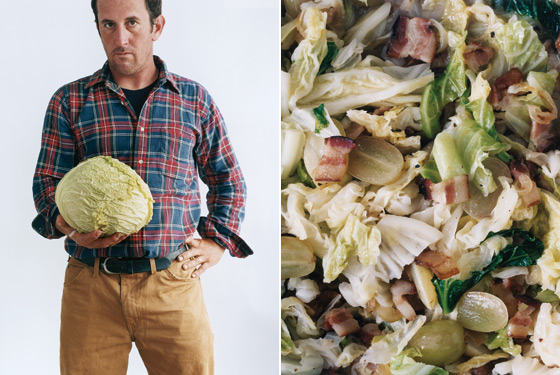
Braised Savoy Cabbage
THE CHEF:
Laurent Tourondel (BLT Market and eleven other BLTs around the country)
To free up oven space for the all-important turkey, Laurent Tourondel recommends braising cabbage on the stove. “It’s a different, faster way to make this homey recipe,” he says. Tourondel likes the addition of bacon, which adds fat and flavor.
THE FARMER:
Chris and Eve Kaplan-Walbrecht (Garden of Eve) Aquebogue; 631-523-6608 or gardenofevefarm.com
Chris and Eve Kaplan-Walbrecht have agricultural roots (Chris grew up on a dairy farm, and Eve has an environmental studies degree), so opening an organic farm on Long Island was only logical. In 2004, the couple started a Community Supported Agriculture group, which supplies vegetables to over 1,000 households and restaurants each week for a fee of $500 per season. “Our cabbages grow with compost and natural fertilizers, and after the frost hits, it makes them even sweeter,” says Chris.
THE RECIPE:
1 large head Savoy cabbage (approximately 2 to 3 pounds)
1 tablespoon olive oil
6 slices thick-cut bacon, sliced crosswise in lardons
12 medium-size cipollini onions, thinly sliced
1 tablespoon honey
1 cup white grapes, halved, seeds removed
1/2 cup chicken stock
5 tablespoons butter, diced
Salt and freshly ground black pepper
3 sage leaves
Quarter the cabbage, remove core, and slice crosswise into 1/2-inch strips. Prepare an ice bath. Bring a large pot of salted water to a boil, add the cabbage, and cook for 2 minutes. Strain the cabbage and immediately transfer into ice bath. Allow to sit for 1 to 2 minutes, then drain, using your hands to squeeze out excess water. Set aside.
Heat a large sauté pan, add the oil and bacon, and cook until bacon turns light brown in color, about 2 minutes. Add the cipollini onions and cook over medium heat until the onions begin to caramelize, about 5 to 8 minutes. Add the honey and continue to cook until well combined. Add the blanched cabbage and grapes, season with salt and pepper, and sauté over high heat until the water releases from the cabbage and evaporates completely. Once the mixture appears dry, add the chicken stock and bring to a simmer over high heat. Add the butter and continue to cook until incorporated. Season to taste with salt and pepper. Once the liquid has thickened, add the whole sage leaves and cook for 2 minutes. Remove from heat and serve immediately.
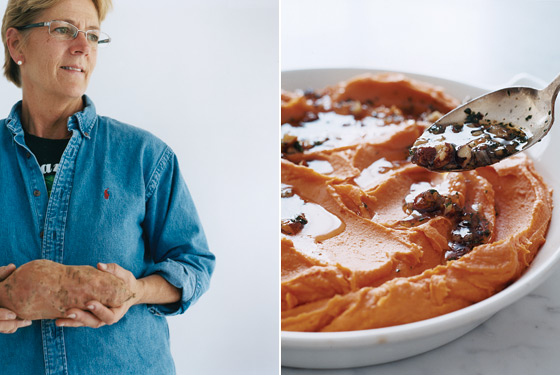
Maple-Whipped Sweet Potatoes
THE CHEF:
Marc Forgione (Forge)
“I always had whipped sweet potatoes with maple syrup as a child on Thanksgiving” says Marc Forgione, who shares a cooking philosophy with his father, ingredient-driven chef Larry Forgione of An American Place. For this dish, Forgione Jr. tweaked his father’s recipe by adding hazelnut brown butter, which has an earthy, nutty flavor, to balance the sweetness of the syrup.
THE FARMER:
Susie Dare (Cherry Lane Farms) Bridgeton, N.J.; 856-455-7043
Susie Dare, who runs an 87-acre family farm with her son Lewis DePietro, has found an enemy in Bambi. “This year was excellent for growing, but the deer were worse than ever; they were quite voracious.” One of the animal’s favorite vegetables is the sweet potato, and whole crops can be lost when the deer eat out the potato tops. Happily, Dare and DePietro managed to outplant their foes’ appetite. Dare credits southern New Jersey’s rich soil for the special flavor of her potatoes. “Also, my farm used to be a dairy farm, and so was well fertilized,” she says.
THE RECIPE:
6 large sweet potatoes
2 tablespoons unsalted butter, at room temperature
3 tablespoons sour cream
3 tablespoons pure maple syrup
Salt and black pepper
HAZELNUT BROWN BUTTER
6 tablespoons unsalted butter
6 tablespoons coarsely chopped hazelnuts
1 medium shallot, minced
3 tablespoons finely chopped Italian parsley
Preheat the oven to 375 degrees. Wash the potatoes and pierce them with a fork. Bake for about 1 hour or until soft when pierced with the point of a knife. When cool enough to handle, peel the potatoes and place in the bowl of a food processor. Add the butter, sour cream, and maple syrup and pulse until the potatoes are smooth. Season to taste with salt and pepper. Transfer to a casserole, cover, and keep warm until ready to serve.
Melt the butter in a medium saucepan over medium-low heat until pale golden, about 4 to 5 minutes. Add the hazelnuts and cook, stirring, over medium heat until the nuts are golden and fragrant, 2 to 3 minutes. Add the shallot and parsley and cook until just softened, about 1 minute. Season to taste with salt and pepper. If the sauce is to be reheated just before serving, the parsley should be added at this stage to keep it fresh and green. Drizzle the hazelnut butter over the top of the sweet potatoes and serve.
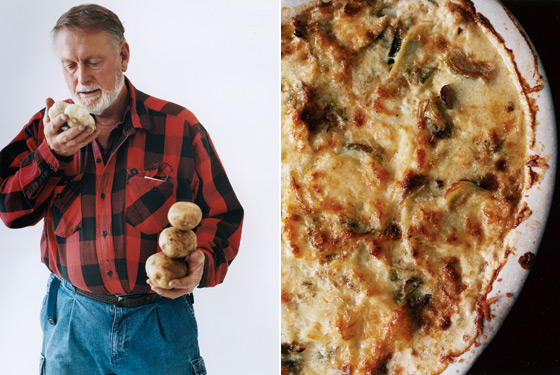
Potato-and-Brussels-Sprout Gratin
THE CHEF:
Alex Guarnaschelli (Butter)
“This is the perfect seasonal side for Thanksgiving,” says Alex Guarnaschelli, who layers the dish with toasty bread crumbs, russet or huckleberry potatoes, and nutty sprouts, then binds it all together with cream to make it tender inside and crunchy on top.
THE FARMER:
Alex Paffenroth (Paffenroth Gardens) Warwick; 845-258-2539
Alex Paffenroth, a fourth-generation Hudson Valley farmer, credits the Union Square Greenmarket with saving his career. “I was originally an onion farmer but almost went out of business because of bad weather,” he says. To diversify, Paffenroth started selling basics, like leeks and squash, at the Greenmarket in 1990, then began following the requests for more exotic vegetables from the various chefs who became his regular customers. He has since expanded his farm to over 200 different vegetables, including 21 types of specialty potatoes, all of which flourish in the Hudson Valley region’s black-dirt soil.
THE RECIPE:
1 tablespoon unsalted butter
2 cloves garlic, minced
4 medium-size russet potatoes (about 3 pounds), peeled, and cut into thin slices
Kosher salt and white pepper
2 cups heavy cream
2 cups whole milk
Pinch ground nutmeg
1 cup grated Parmesan cheese
3/4 cup grated Gruyère cheese
2 tablespoons olive oil
11/2 pounds Brussels sprouts, trimmed and thinly sliced
2 teaspoons granulated sugar
Pinch paprika
1/2 cup bread crumbs
1/4 cup ground, toasted almonds
Preheat the oven to 350 degrees.
Grease a 12-inch gratin dish with butter. Sprinkle the minced garlic over the bottom of the dish.
Place potato slices in a saucepan and season with salt and pepper. Cover with cream, milk, and nutmeg; mix well. Place saucepan over low heat and simmer for 10 minutes. Do not stir the mixture too frequently, to avoid breaking the potatoes. Stir in ½ cup of Parmesan cheese and ½ cup of Gruyère cheese. Season with salt and pepper.
Heat the oil in a skillet; when it begins to smoke lightly, add Brussels-sprout slices and season with salt, pepper, and sugar. Sauté for 1–2 minutes, until they start to wilt slightly. Drain excess oil, sprinkle with paprika, and set aside.
Arrange of the potato-cream mixture in the bottom of the gratin dish. Top with of the Brussels sprouts and sprinkle with Parmesan and Gruyère cheese. Repeat the process twice more; pour remaining cream over the gratin and sprinkle with cheese.
Bake gratin until tender when pierced with a knife, 40 to 45 minutes. Combine the bread crumbs and almonds, sprinkle over the gratin, and bake for 10 minutes. Set aside to cool for about 20 minutes before serving.
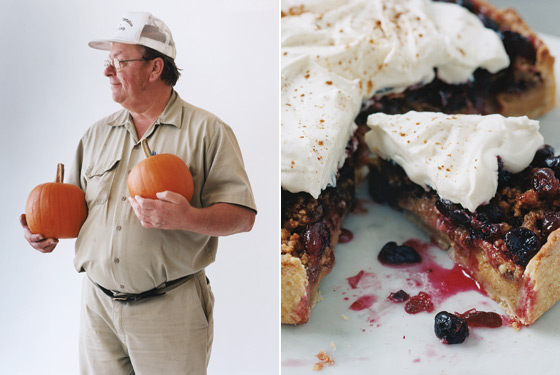
Deep-Dish Pumpkin Pie
THE CHEF
Peter Hoffman (Savoy and Back Forty)
Pumpkins are a fall essential.“They go back to the Native Americans,” says Peter Hoffman. He puts a unique spin on his pie by topping it with a walnut crunch and including cranberries.
THE FARMER:
Ted Blew (Oak Grove Plantation) Pittstown, N.J.; 908-782-9618
For 31 years, Ted Blew has run an organic, sustainable farm with his wife, Susan, and his four children. “I’ve always had a dream of self-sufficiency,” says Blew (three years ago, he installed solar panels to supply all the farm’s electrical needs). Blew’s farm, a stalwart at the Union Square Greenmarket, produces sixteen varieties of pumpkin, including mystic and cheese pumpkins, both of which Blew recommends for use in pies. “The flavor is most intense in these two varieties,” he says.
THE RECIPE:
PIE DOUGH
1 1/4 cups all-purpose flour
4 1/2 teaspoons sugar
1/4 teaspoon salt
1 stick butter, cut into 1/2-inch pieces
1 egg yolk
Combine flour, sugar, and salt in the bowl of a food mixer fitted with a paddle. Add butter and beat until it forms pea-size pieces. Whisk together yolk and 2 tablespoons water and add to flour; mix until dough is just combined. Wrap in plastic and refrigerate for 1 hour.
Preheat oven to 400 degrees.
On a floured surface, roll the dough to form a 12-inch circle. Line a 9-inch springform pan with dough (allow it to come two-thirds of the way up the sides). Prick the dough with a fork, line with parchment paper, and weigh down with dried beans. Bake for 15 minutes, remove paper and beans, and bake until the crust is slightly brown, 3 to 4 minutes.
PUMPKIN FILLING
1 small cheese pumpkin
1/4 cup granulated sugar
2 tablespoons dark brown sugar
1/2 teaspoon cinnamon
1/8 teaspoon ginger
1/8 teaspoon cloves
1/4 teaspoon salt
2 eggs
1/2 teaspoon vanilla
6 ounces evaporated milk
WALNUT CRUNCH
2 tablespoons all-purpose flour
1 cup walnuts
1 cup light brown sugar
1 teaspoon cinnamon
1/4 cup cold butter, cut into pieces
1/2 cup almond paste, diced
Filling: Preheat oven to 350 degrees.
Split pumpkin in half, remove seeds, and place halves on a baking sheet. Roast until tender, about 2 hours. When cool, scoop out flesh and purée in a food processor. Measure 8 ounces of pumpkin purée.
In a bowl, whisk together the sugars, cinnamon, ginger, cloves, and salt. Beat in eggs, vanilla, milk, and then the purée. Pour into the precooked shell and bake at 350 degrees for 35 minutes or until the custard is slightly jiggly in the center.
Crunch: Put flour, walnuts, sugar, and cinnamon in the bowl of a food processor. Add butter and almond paste and pulse until crumbly. Spread walnut crunch over the top of the pumpkin filling and bake for 15 minutes, until crisp. Remove and allow the pie to come to room temperature.
CRANBERRY AND WHIPPED-CREAM-CHEESE TOPPINGS
11/2 cups cranberries
1/2 cup sugar plus 2 teaspoons
8 ounces cream cheese
1/3 cup heavy cream
Cook cranberries and 1/2 cup sugar gently in a saucepan until they form a jammy consistency. Remove from heat and allow to cool.
Whisk cream cheese, cream, and 2 teaspoons sugar in bowl of a food mixer until medium peaks form.
Spread cranberry mixture over the top of the walnut crunch, finish with whipped cream cheese.
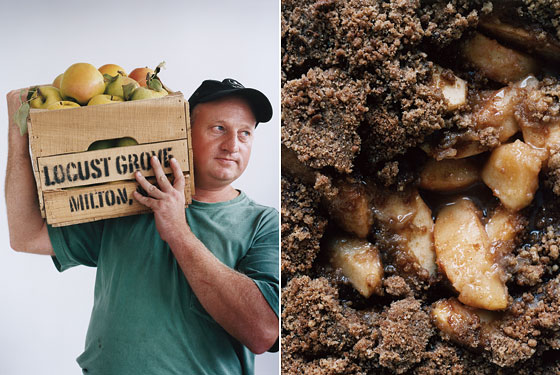
Mary Ann White’s Apple Crisp
THE CHEF:
Michael White (Convivio and Alto)
Michael White is known for his high-end Italian fare, but when it comes to Thanksgiving, he’s all-American. “I can still smell my mom’s apple crisp,” he says. The Mutsu apples he uses, he says, are almost too juicy for a pie.
THE FARMER:
Jim Kent Jr. (Locust Grove Fruit Farm) Milton; 845-795-5194
Jim Kent Jr.’s seventh-generation Hudson Valley family was one of the founding farmers of the Greenmarket, in 1976. “It wasn’t especially nice, but it was better than selling the fruit off the back of a truck,” says Kent. Today, Locust Grove sells over 60 varieties of apples, including the popular Mutsu. “Mutsu apples were called crispins when they were first introduced in America in the forties,” says Kent. By any name, he adds, the variety stands out for its juiciness, sweetness, and ability to retain its shape when cooked.
THE RECIPE:
8 tablespoons butter, diced, plus extra for greasing dish
1/2 cup granulated sugar
2 teaspoons ground cinnamon
3 1/2 pounds Mutsu apples, peeled, cored, cut into eighths
1 1/2 tablespoons fresh lemon juice
1 cup all-purpose flour
1 cup packed dark brown sugar
Preheat the oven to 425 degrees. Butter a 9-inch-square baking dish.
Combine the granulated sugar and 1 teaspoon cinnamon in a bowl. Add the apples and lemon juice, toss together, and transfer to the prepared baking dish.
Combine the flour and brown sugar and remaining cinnamon in a bowl. Cut the butter into the mixture until it resembles fine crumbs. Sprinkle the topping evenly over the fruit to cover (it will make a generous layer).
Bake in the oven for 15 minutes, reduce the oven temperature to 350 degrees, and cook for 25–30 minutes more, or until the top is golden and fruit is bubbly. (If the topping browns too quickly, cover loosely with foil.) Cool the crisp on a wire rack for 15 minutes. Serve with vanilla ice cream or vanilla-flavored whipped cream.